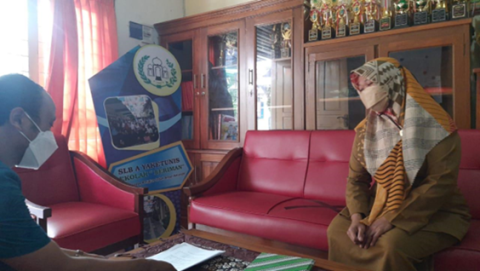You are here
ELECTRONICS LECTURER DEVELOP BRAILLE HIJAIYAH LEARNING MEDIA
Primary tabs

Indonesia is one of the countries with the highest number of blind people in the ASEAN region. The blind community in Indonesia is a society that so far has not received full attention from the community and the government. The reality is that nowadays in this era of increasing technology, it turns out that it is not being matched by measures to equalize education for the blind. One of the lessons that has received less attention is learning the Qur'an for the blind. Most of the blind in Indonesia are Muslims, which of course cannot be separated from the habit of reading the Koran. However, due to the lack of appropriate learning media, many blind people in Indonesia do not recognize hijaiyah letters and cannot read the Koran. One of the places used for educational learning for blind people is Special Schools (SLB), but in reality these places still experience a shortage of learning media, especially learning media for hijaiyah letters. Seeing from the above problems the UNY Electronics lecturer service group provides a solution by developing Braille Hijaiyah Electronics to help recognize Braille Hijaiyyah letters for the blind.
The target use of this product is children or people who are still learning to recognize hijaiyah letters. This tool is equipped with a button that appears so that it can be touched by blind people. The tool is also equipped with sound output if the button is pressed by the user, according to the pattern of hijaiyyah braille letters. The application of this tool was carried out at SLB A Yaketunis which is located at Jalan Parangtritis no. 4 Yogyakarta. The service was carried out by Anggun Winursito, M.Eng., Ir. Ardy Seto Priambodo, M.Eng., and Octave Agni Dhewa, M.Cs. For the initial stage in this program is observation in the field. This is done to determine the condition of the field so that later in the design of the tool an overview of the problems from the field will be known which will then be addressed by the solutions from the proposed program. Follow-up survey activities have been carried out at the service location, namely SLB A Yaketunis Yogyakarta to find out further problems at the location. The survey was carried out with representatives of community service members and was welcomed by the Principal of SLB A Yaketunis. The results of the survey that has been carried out, there are several requirements that must be implemented in electronic braille devices in their development. Some things that must be added are systems that can monitor the independent learning process of SLB students at home. In addition, the design of the tool is also a concern of the team to prioritize students' comfort in using the tool.
The use of this product is quite easy and practical because it uses a battery in its operation. In addition, the form of this product is portable so that it is easy to carry around while doing learning both in class and outside the classroom independently. The features of this tool can help students recognize hijaiyah letters. The results of the application are considered quite good. All the functionality of this product can function properly. From the implementation during several stages, it can be seen that by using this product, SLB students can learn to recognize and distinguish one hijaiyah letter from another. In addition, this tool becomes an enjoyable game, where students learn while playing.
Contact Us
Address : Kompleks Fakultas Teknik Kampus Karangmalang, Yogyakarta, 55281
Telephone : +62 274554686
Email : pte_ft@uny.ac.id
Copyright © 2024,
